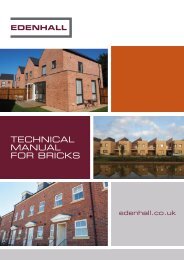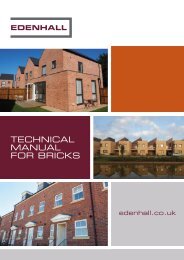Create successful ePaper yourself
Turn your PDF publications into a flip-book with our unique Google optimized e-Paper software.
BRICK TECHNICAL BULLETIN<br />
CONCRETE ENGINEERING QUALITY BRICKS<br />
BTB 11<br />
INTRODUCTION<br />
Concrete Engineering Quality Bricks (EQs) produced by <strong>Edenhall</strong> satisfy the majority of criteria in terms of technical performance, but<br />
more importantly they are produced at a number of strategically placed factories across the country and are generally available on an<br />
ex stock basis. They were introduced over 30 years ago following the result of an extensive independent research and development<br />
programme and have been widely used in all forms of civil and general construction since then.<br />
Produced in a solid form, a format in which the clay brick manufacturers may have limited volumes, the <strong>Edenhall</strong> EQ brick offers a cost<br />
competitive solution for ground works and utility constructions.<br />
HISTORY<br />
The EQ brick was developed originally by <strong>Edenhall</strong> in the mid 1980s and its concept was adopted nationally by other concrete<br />
brick producers who existed at that time. The background was that there was a shortage of Clay Class Bs and a suitable<br />
alternative was required.<br />
The original Standards for concrete bricks of BS 6073 and prior to that BS 1180, included a category for the production of ‘Special<br />
Purpose’ bricks which had a minimum cement content of 350kg/m 3 but with no recommendation as to where they could be used.<br />
Research by <strong>Edenhall</strong> showed that although there were significant examples of other precast concrete units being used in<br />
underground and aggressive locations. eg. concrete pipes, rings, precast concrete manholes etc., there were no examples of<br />
performance of concrete bricks in these locations. A typical concrete brick in those days tended to be limited to a strength of<br />
20N/mm 2 which restricted its use to above and below dpc.<br />
The Building Research Establishment had carried out work in 1970 with concrete buried in sulphate bearing soils and had concluded<br />
that the criteria for suitability under these conditions was a low absorption, sulphate resistant unit. BRE Digest 250, which was really<br />
concerned with in-situ concrete, did allow precast units as long as they were made with some form of sulphate resisting cement for up<br />
to Class 3 sulphate levels.<br />
<strong>Edenhall</strong> then embarked on a programme of testing which resulted in the production of a brick with a minimum cement content of<br />
350kg/m 3 and made from a cement mixture of either sulphate resisting cement (SRPC) or Ordinary Portland Cement and cement<br />
replacements such as Ground Granulated Blast Furnace Slag (GGBS) or Pulverised Fuel Ash (PFA). These blends gave the same<br />
degree of sulphate resistance as bricks made with SRPC.<br />
To carry out a performance comparison of concrete and clay Class B bricks <strong>Edenhall</strong> commissioned the Laing Design and<br />
Development Centre to institute a six month programme. The test involved the construction of three walls of a simulated blocked<br />
manhole using three different types of concrete bricks (limestone, basalt, and limestone aggregates at 40, 40, and 20 N/mm 2<br />
respectively). The fourth was built using a Clay Class B brick. The chamber was filled with a simulated acidic effluent, the pH of<br />
which was maintained throughout the six month experiment. Laing’s subsequent report gave conclusions as follows:<br />
‘The evidence produced shows that any of the three types of concrete brick is suitable for manhole construction, but if there is a<br />
preference it is for the 40N/mm 2 limestone one’.<br />
‘All three types performed extremely well and only lost fractions of a millimetre at their exposed surfaces in an acid effluent for 6<br />
months and only then from the three month interval’.<br />
‘Under practical conditions of use, a lifetime of many decades can be predicted for any of the bricks provided good workmanship<br />
is followed and the conditions of exposure lie within the ranges tabulated’.<br />
Following these test results <strong>Edenhall</strong> applied for an Agrément Certificate which was granted in 1986. This Agrément Certificate has<br />
not been replaced as the collated data from it formed part of the updated concrete masonry Standard BS 6073 and subsequently<br />
BS 771-3.<br />
TYPICAL APPLICATIONS<br />
<strong>Edenhall</strong> Engineering Quality bricks are particularly suitable above and below ground level where aggressive conditions occur and/<br />
or where natural sulphate levels up to and including Class 3 are present. They are especially suitable in chimney stacks, manholes,<br />
drainage inspection chambers, retaining walls, copings and caps and other constructions subject to aggressive conditions.







